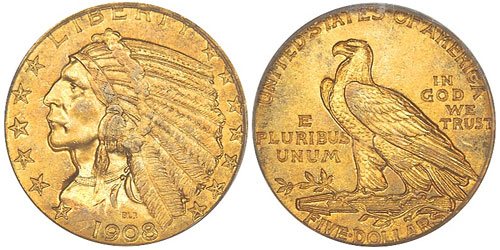Indian Half Eagle
Source: My Coin Guides: The Indian Head Half Eagle was introduced in 1908 along with the quarter eagle of the same design. Although the American public and some newspapers were not happy with the incuse design when the coins were first released, today the Indian Half Eagle is a popular series to collect. Assembling a complete set is a reasonable task, and a good start for a collector who wishes to put together a specific set of American gold coinage. Most issues are affordable, with the exception of two coins which are scarce in all grades, and several coins which become expensive in higher grades.

During the early 20th century an increasing number of people, including President Roosevelt became tired with the circulating coin designs. Some had been introduced almost a lifetime earlier, during the 1830’s. Others, like the silver denominations, had seen alterations during the late 20th century, but were not considered to be true pieces of art. It was believed that the coinage of a nation should reflect the artistic skills of that country. After the turn of the century, the circulating coins of the United States were gradually replaced starting with the gold coins.
In 1907, the double eagle (twenty dollar) and eagle (ten dollar) saw their first major alteration in 57 years and 69 years, respectively. The double eagle was redesigned with a full figure of Liberty. The eagle, a denomination which was first struck in 1795, would feature Liberty with an Indian headdress. In the following year, the two remaining gold denominations, the half eagle and quarter eagle would also have their designs changed.
It has been generally believed that Dr. William Sturgis Bigelow, who was a close friend of President Roosevelt, was the one who suggested making the designs for the new minor gold coins incuse. Up to that point, all United States coinage featured a raised design and rim, although an intaglio design was opted back in 1792. The idea for incuse designs fit with Roosevelt’s desire to make the gold coins look like the coins from Ancient Greece, considered to be of true grandeur. After apparently receiving Roosevelt’s approval, Bigelow contacted Boston sculptor Bela Lyon Pratt to design the new coins. Communications related to the new design between Bigelow, Pratt and Roosevelt began as early as October 1907.
The designs were finalized in late June of 1908, and production started during the last few months of 1908, at the Philadelphia Mint only. The obverse of the Indian Head Half Eagle features an Indian male chief waring a ceremonial headdress. The word LIBERTY appears above, thirteen stars surround, and the date appears below. The reverse an eagle perched on a bundle of arrows intertwined with an olive branch. E PLURIBUS UNUM appears in the left field, IN GOD WE TRUST is in the right field, UNITED STATES OF AMERICA is above, and the denomination FIVE DOLLARS is below.
The Indian Half Eagle series is relatively small, with a total of 24 date and mintmark combinations struck between 1908 and 1929. Twenty three of the coins were struck between 1908 and 1916, and the final date was struck at the Philadelphia Mint in 1929. At that time, virtually all gold coins had been removed from circulation due to the worldwide economic situation. After the recall of all gold coins in the 1930, many of the final issue of the type were subsequently melted.
